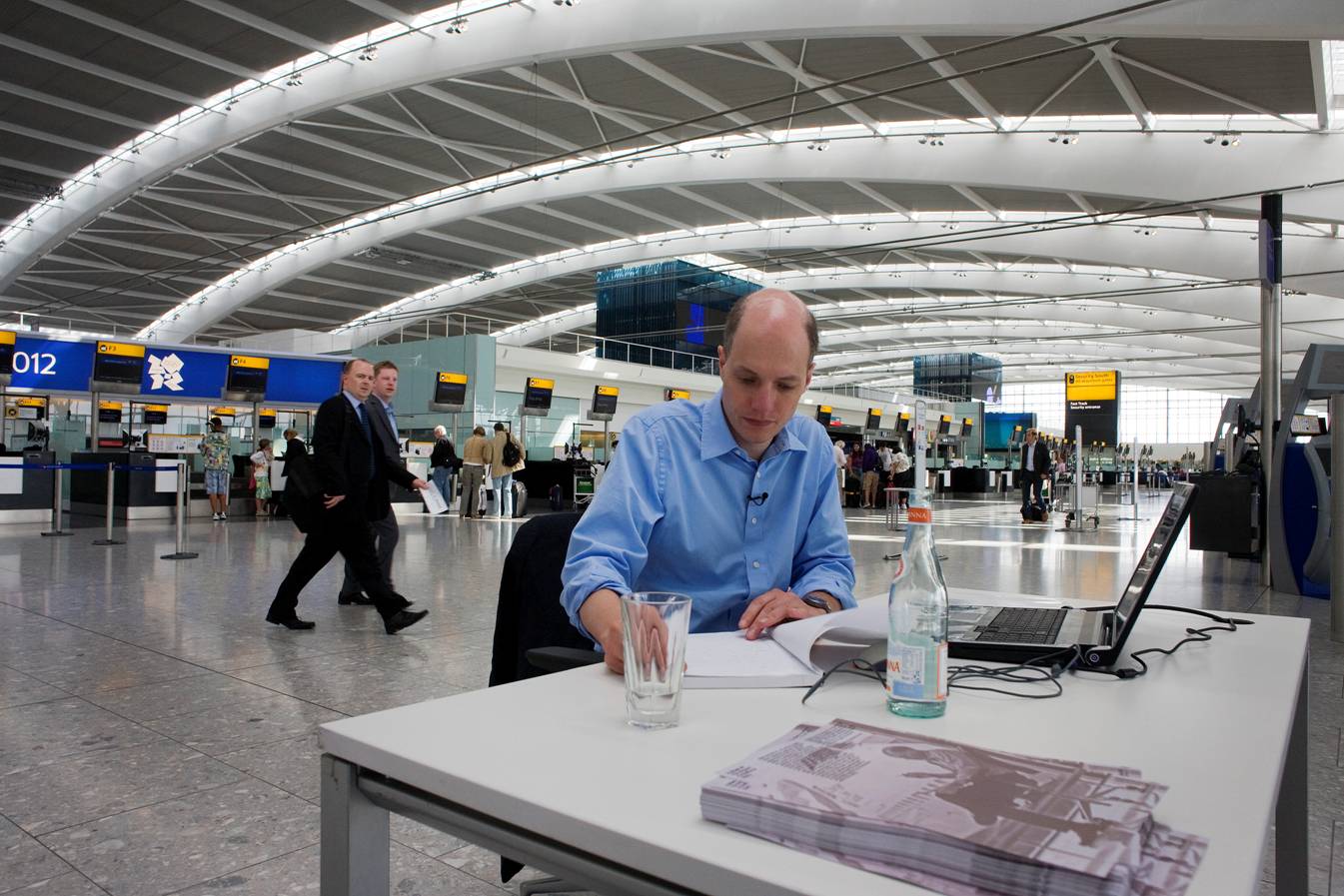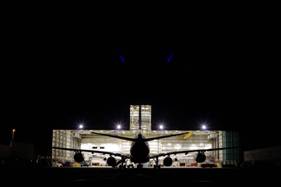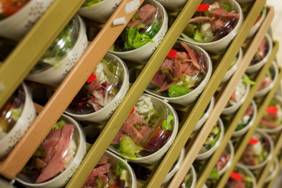
In the literary equivalent of Run D.M.C. singing about their Adidas, Heathrow Airport last month hired Alain de Botton to write a book based on spending a week at its Terminal Five. The airport plans to give away 10,000 free copies of the book to those passing through its gates, but for the rest of us, A Week At The Airport: A Heathrow Diary is available for sale online beginning today. It also includes photographs by Richard Baker (who shot the images featured here, and whose Heathrow collection, among others, is posted here). De Botton, most recently the author of The Pleasures and Sorrows of Work
and a past guest of Zócalo, e-mailed us the following excerpt the morning after his visit to a hangar.
 Every night a few planes would be towed away from their gates to a set of giant hangars, large enough to swallow up all but their tails, where a phalanx of gangways and cranes would lock themselves around their organically shaped bodies like a series of handcuffs. While aircraft tended to be coy about their need to pay such visits – hardly letting on, at the close of a trip from Los Angeles or Hong Kong, that they had reached the very end of their permitted quota of nine hundred flying hours – the checks provided an opportunity for them to reveal their individuality. What to passengers might have looked like yet another indistinguishable 747 would emerge, during this process, as a machine with a distinct name and medical history: G-BNLH, for example, had come into service in 1990 and in the intervening years had had three hydraulic leaks over the Atlantic, once blown a tire in San Francisco and, only the previous week, dropped an apparently unimportant part of its wing in Cape Town. Now it was coming into the hangar with, among other ailments, twelve malfunctioning seats, a large smear of purple nail polish on a wall panel in business class and an opinionated microwave oven in a front galley that ignited itself whenever an adjacent basin was used.
Every night a few planes would be towed away from their gates to a set of giant hangars, large enough to swallow up all but their tails, where a phalanx of gangways and cranes would lock themselves around their organically shaped bodies like a series of handcuffs. While aircraft tended to be coy about their need to pay such visits – hardly letting on, at the close of a trip from Los Angeles or Hong Kong, that they had reached the very end of their permitted quota of nine hundred flying hours – the checks provided an opportunity for them to reveal their individuality. What to passengers might have looked like yet another indistinguishable 747 would emerge, during this process, as a machine with a distinct name and medical history: G-BNLH, for example, had come into service in 1990 and in the intervening years had had three hydraulic leaks over the Atlantic, once blown a tire in San Francisco and, only the previous week, dropped an apparently unimportant part of its wing in Cape Town. Now it was coming into the hangar with, among other ailments, twelve malfunctioning seats, a large smear of purple nail polish on a wall panel in business class and an opinionated microwave oven in a front galley that ignited itself whenever an adjacent basin was used.
Thirty men would work on the plane through the night, the whole operation guided by an awareness that while the craft could under most circumstances be extraordinarily forgiving, a chain of events originating in the failure of something as small as a single valve could nevertheless bring it down, just as a career might be ruined by one incautious remark, or a person die because of a clot less than millimetre across.
 Strolling through G-BNLH’s cabin offered some of the same sense of excitement, of rule-breaking, as wandering around a church or a supermarket in the early hours might have done. I crossed from one class to another without impediment and had a rest on one of the beds at the front of the plane, through whose window I watched the dangling feet of a man engaged in repairing the cockpit’s windshield wipers a few metres above. I toured the exterior of the aircraft on a gangway that ran around its midriff and let my hands linger on its nose cone, which had only a few hours earlier carved a path through dense layers of static cumulus clouds. Studying the plane’s tapered tail, and the marks left across the back of its fuselage by the enraged thrust of its four RB211 engines, I wondered if scientists and engineers might have designed planes and their means of takeoff differently had our species been graced with some subtler, less thunderous mode of conception, perhaps one managed frictionlessly and quietly by the male’s sitting for a few hours on an egg left behind in a leafy recess by the female.
Strolling through G-BNLH’s cabin offered some of the same sense of excitement, of rule-breaking, as wandering around a church or a supermarket in the early hours might have done. I crossed from one class to another without impediment and had a rest on one of the beds at the front of the plane, through whose window I watched the dangling feet of a man engaged in repairing the cockpit’s windshield wipers a few metres above. I toured the exterior of the aircraft on a gangway that ran around its midriff and let my hands linger on its nose cone, which had only a few hours earlier carved a path through dense layers of static cumulus clouds. Studying the plane’s tapered tail, and the marks left across the back of its fuselage by the enraged thrust of its four RB211 engines, I wondered if scientists and engineers might have designed planes and their means of takeoff differently had our species been graced with some subtler, less thunderous mode of conception, perhaps one managed frictionlessly and quietly by the male’s sitting for a few hours on an egg left behind in a leafy recess by the female.




Send A Letter To the Editors